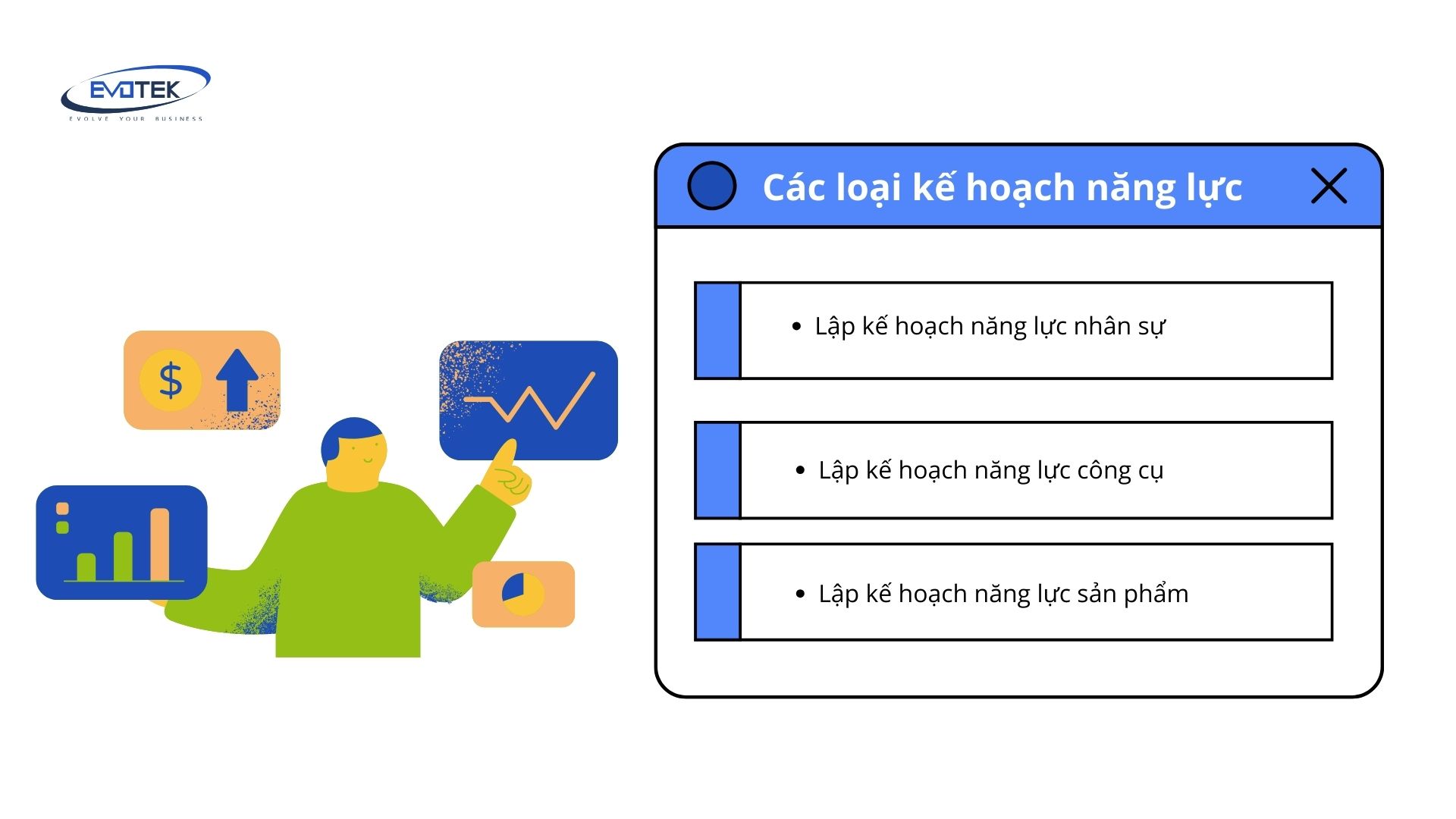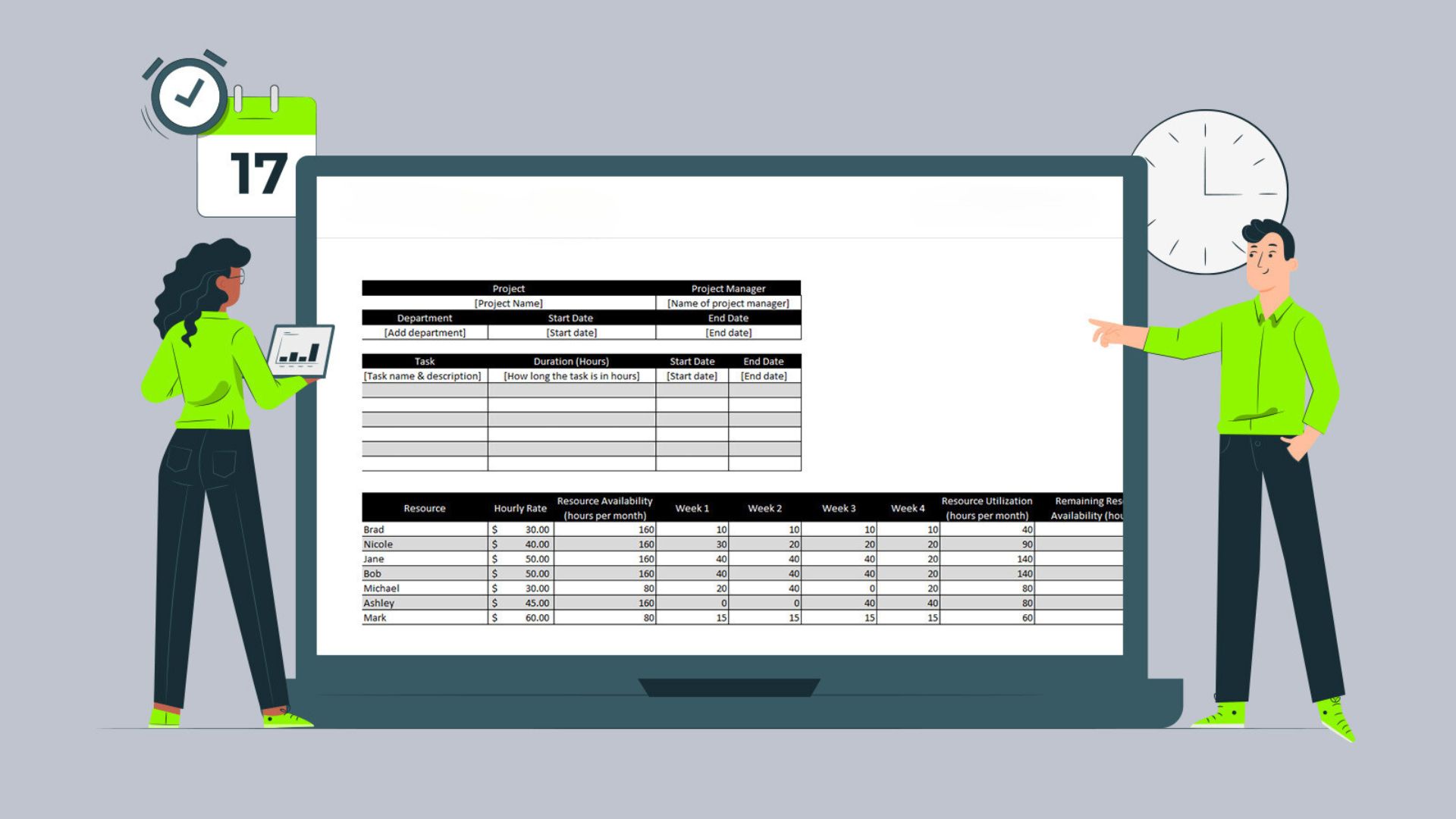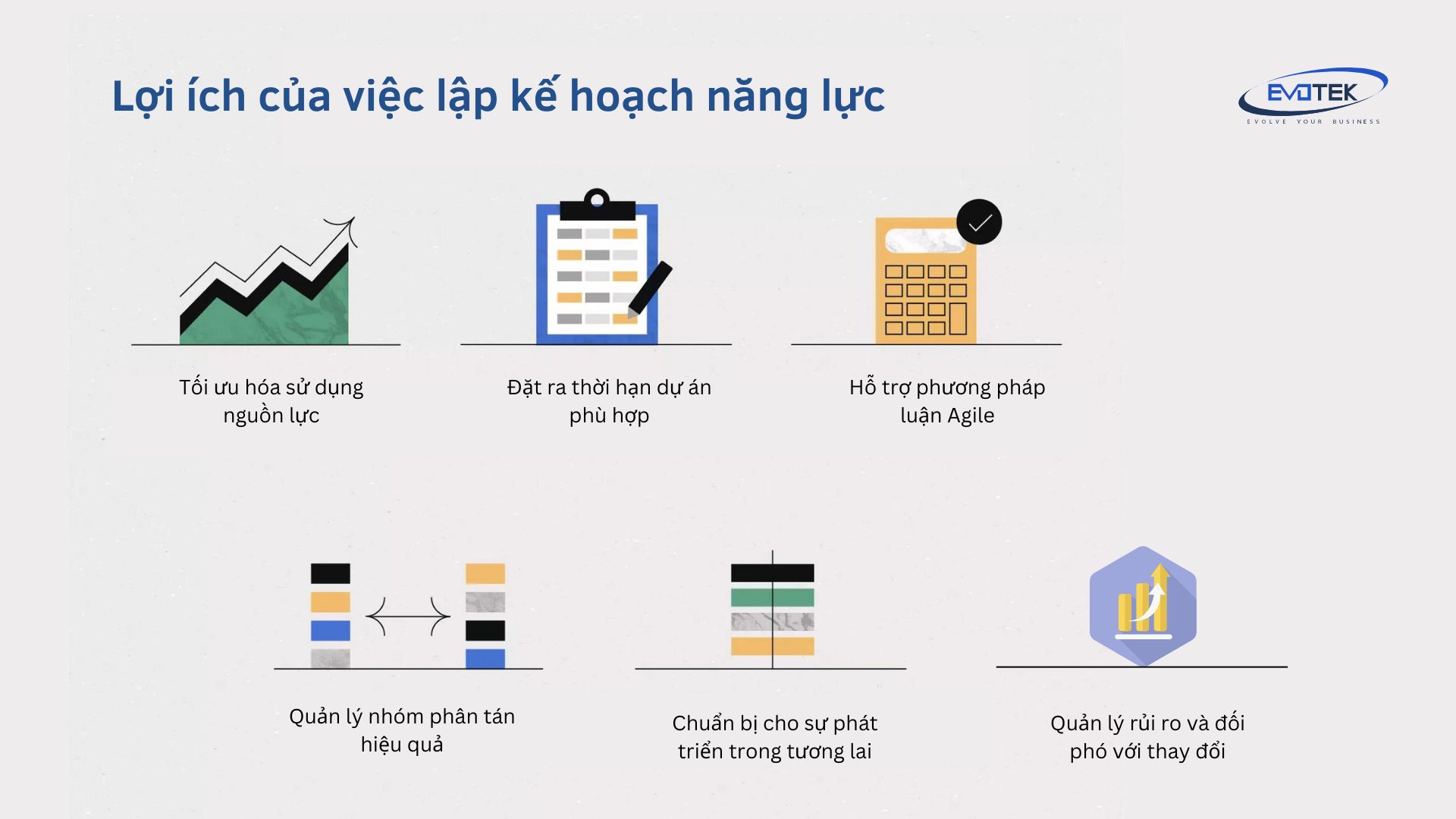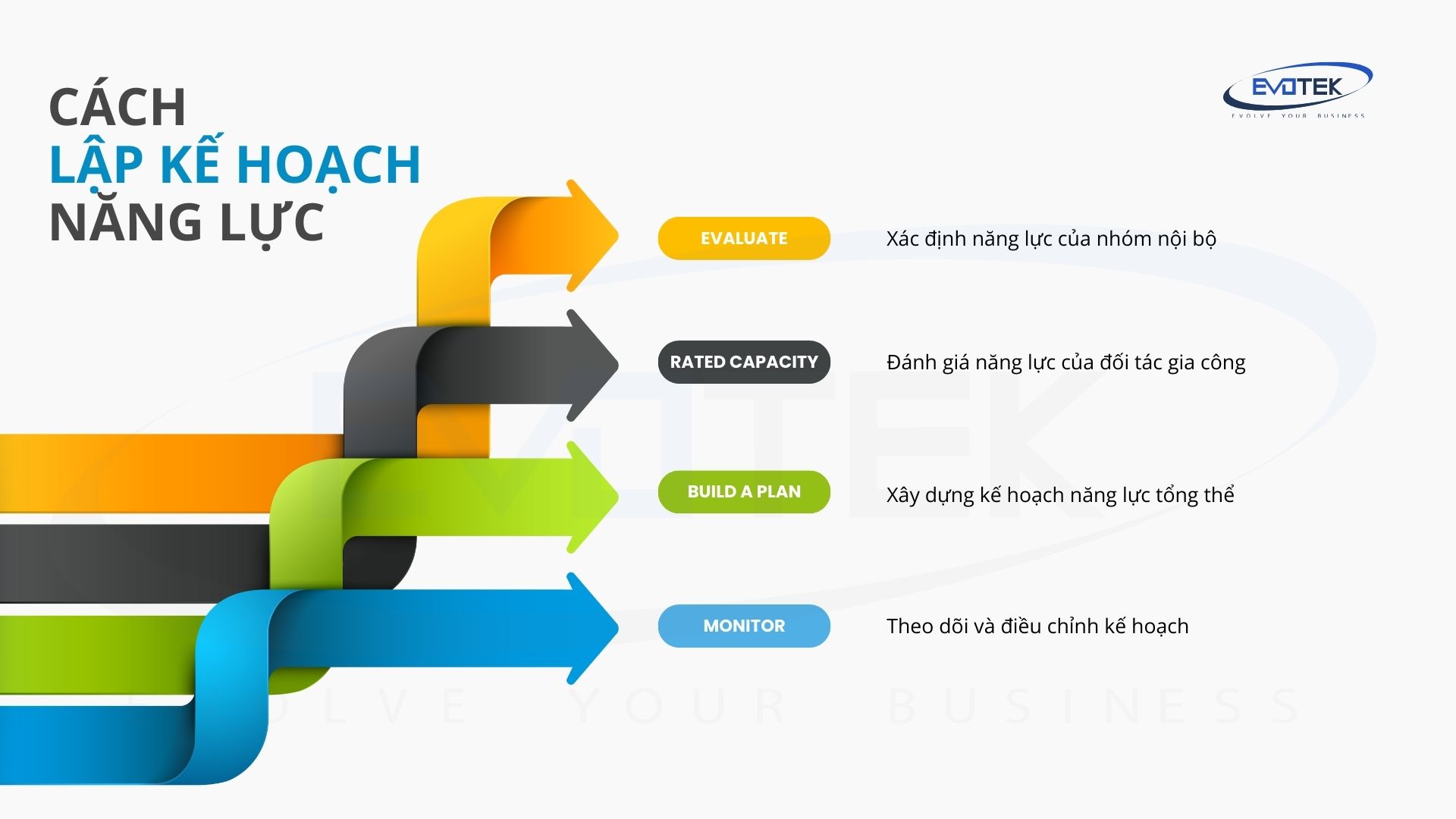Trong môi trường công nghệ luôn thay đổi nhanh chóng, các nhóm phát triển phần mềm cần phải linh hoạt và có khả năng đáp ứng kịp thời với những thay đổi trong nhu cầu của khách hàng. Để đạt được điều này, họ cần nắm rõ năng lực của đội ngũ của mình. Quản lý năng lực không chỉ đơn giản là đảm bảo có đủ nhân sự với kỹ năng phù hợp ở đúng vị trí và đúng thời điểm. Còn nhiều yếu tố khác cần được cân nhắc để quá trình này diễn ra hiệu quả.
Trong hướng dẫn này, chúng tôi sẽ cung cấp cho bạn tất cả kiến thức cần thiết về quản lý năng lực, từ việc hiểu tốc độ làm việc của nhóm đến việc sử dụng dữ liệu lịch sử để dự đoán nhu cầu trong tương lai. Điều này sẽ giúp nhóm của bạn luôn sẵn sàng đáp ứng những thay đổi một cách nhanh chóng và linh hoạt
Lập kế hoạch năng lực là gì?
Lập kế hoạch năng lực là quá trình chiến lược xác định khả năng thực hiện công việc của một tổ chức hoặc nhóm trong một khoảng thời gian nhất định. Nó tập trung vào việc đánh giá năng lực hiện tại và tiềm năng phát triển của nhân lực, nhằm đảm bảo nguồn lực phù hợp để đáp ứng nhu cầu kinh doanh
Quá trình lập kế hoạch bao gồm hai loại hoạch định chính:
Kế hoạch năng lực dài hạn: Phân tích xu hướng và chiến lược của tổ chức để xác định các lĩnh vực cần phát triển năng lực trong tương lai, giúp định hướng cho việc tuyển dụng, đào tạo và phát triển nhân sự phù hợp với mục tiêu dài hạn của doanh nghiệp.
Kế hoạch năng lực ngắn hạn: Sử dụng dữ liệu từ các chu kỳ công việc trước đó để ước tính khối lượng công việc mà nhóm có thể hoàn thành trong chu kỳ sắp tới, giúp phân bổ nguồn lực hiệu quả, lên lịch công việc và quản lý tải trọng một cách chính xác hơn.
Mặc dù lập kế hoạch năng lực dài hạn định hướng chiến lược tổng thể, nhưng lập kế hoạch năng lực ngắn hạn lại có tác động trực tiếp đến hoạt động hàng ngày. Nó cung cấp bức tranh chi tiết về khả năng thực hiện công việc dựa trên dữ liệu lịch sử, giúp nhóm đưa ra ước tính chính xác hơn về việc có thể hoàn thành bao nhiêu công việc trong tương lai gần.
Quá trình lập kế hoạch năng lực bao gồm các bước quan trọng sau:
- Đánh giá năng lực hiện tại của nhân viên để xác định khối lượng công việc có thể hoàn thành.
- Xác định các lĩnh vực có nhu cầu bổ sung nhân sự mới.
- Lên kế hoạch tuyển dụng và thời điểm phù hợp để tuyển nhân viên mới.
- Lập kế hoạch nghỉ phép và thời gian nghỉ của nhân viên.
- Xác định nhu cầu đào tạo và phát triển kỹ năng cho nhân viên hiện tại.
Điều đáng lưu ý là lập kế hoạch năng lực khác với dự báo. Dự báo sử dụng dữ liệu lịch sử để đưa ra dự đoán về tương lai, trong khi lập kế hoạch năng lực tập trung vào việc hiểu năng lực hiện tại để đưa ra quyết định sáng suốt về phân bổ nguồn lực và đáp ứng nhu cầu kinh doanh trong tương lai.
Các loại kế hoạch năng lực

1. Lập kế hoạch năng lực nhân sự
Đối với các nhà phát triển phần mềm, quá trình lập kế hoạch năng lực nhân sự có ý nghĩa quan trọng trong việc đảm bảo nguồn nhân lực chất lượng cao, đáp ứng nhu cầu phát triển sản phẩm và dịch vụ một cách liên tục. Quá trình này bao gồm các bước chiến lược như:
- Phân tích nhu cầu hiện tại về nhân lực: Đánh giá số lượng và kỹ năng của nhân viên hiện có trong các lĩnh vực phát triển phần mềm, kiểm thử, bảo trì, và gia công, xác định những khoảng trống hoặc dư thừa về nguồn nhân lực chuyên môn.
- Dự báo nhu cầu tương lai: Dựa trên các yếu tố như chiến lược phát triển sản phẩm, công nghệ mới, xu hướng thị trường, và nhu cầu khách hàng, dự đoán nhu cầu về số lượng và kỹ năng lao động trong tương lai, đặc biệt là trong các lĩnh vực mũi nhọn như phát triển phần mềm, trí tuệ nhân tạo, Internet of Things (IoT), và các công nghệ mới nổi khác.
- Phân tích khoảng cách: So sánh nhu cầu hiện tại và dự báo tương lai để xác định những khoảng cách về số lượng và kỹ năng lao động cần được điều chỉnh, đặc biệt trong các lĩnh vực then chốt như lập trình, thiết kế, kiến trúc phần mềm, và quy trình gia công.
- Xây dựng kế hoạch hành động: Phát triển các chiến lược và kế hoạch để giải quyết những khoảng cách đã xác định, bao gồm tuyển dụng nhân tài mới, đào tạo nâng cao kỹ năng cho nhân viên hiện có, chương trình phát triển chuyên môn, hoặc hợp tác với các đơn vị gia công phần mềm bên ngoài khi cần thiết.
- Triển khai và giám sát: Thực hiện các kế hoạch hành động, theo dõi và điều chỉnh liên tục để đảm bảo nguồn nhân lực phù hợp với nhu cầu biến đổi của dự án phát triển phần mềm và dịch vụ gia công.
Lập kế hoạch năng lực nhân sự hiệu quả giúp tổ chức sử dụng nguồn nhân lực một cách hiệu quả, tối đa hóa năng suất và lợi nhuận. Nó cũng góp phần tạo ra một môi trường làm việc hấp dẫn, phát triển sự gắn kết và động lực cho nhân viên. Tổ chức nào hiểu rõ tầm quan trọng của quá trình này sẽ có lợi thế cạnh tranh lâu dài trong việc thu hút và giữ chân nhân tài.
2. Lập kế hoạch năng lực công cụ

Lập kế hoạch năng lực công cụ đóng vai trò quan trọng trong quá trình phát triển phần mềm, đảm bảo rằng nhóm dự án có đủ nguồn lực công nghệ cần thiết để đáp ứng các mục tiêu và đạt được hiệu suất tối đa. Lập kế hoạch năng lực công cụ bao gồm lập kế hoạch và cung cấp phần cứng máy tính, phần mềm, công cụ lập trình, môi trường phát triển tích hợp (IDE), công cụ kiểm thử, hệ thống quản lý mã nguồn, cơ sở dữ liệu và bất kỳ công nghệ hoặc công cụ khác cần thiết cho chu kỳ phát triển phần mềm.
Việc lập kế hoạch năng lực công cụ hiệu quả đảm bảo rằng mọi thành viên trong nhóm đều có quyền truy cập vào các công cụ cần thiết để hoàn thành nhiệm vụ của mình. Điều này giúp tăng năng suất và hiệu quả làm việc, đồng thời giảm thiểu rủi ro chậm trễ hoặc lỗi do thiếu nguồn lực công nghệ. Ngoài ra, kế hoạch này cũng bao gồm việc lập kế hoạch bảo trì, nâng cấp và thay thế các công cụ khi cần thiết để đảm bảo chúng luôn được cập nhật và hoạt động ổn định.
Khi yêu cầu của dự án thay đổi hoặc công nghệ mới ra đời, kế hoạch năng lực công cụ cần được điều chỉnh để phù hợp để đảm bảo rằng nhóm luôn có đủ nguồn lực để đáp ứng nhu cầu mới và tận dụng các công nghệ tiên tiến nhất. Đồng thời, việc lập kế hoạch hiệu quả cũng giúp tối ưu hóa chi phí bằng cách chỉ đầu tư vào các công cụ cần thiết và tránh lãng phí.
Bằng cách lập kế hoạch năng lực công cụ một cách chu đáo, các nhà phát triển phần mềm có thể tập trung vào công việc chính của họ mà không gặp phải trở ngại về công nghệ, đảm bảo tiến độ và chất lượng dự án.
3. Lập kế hoạch năng lực sản phẩm
Lập kế hoạch năng lực sản phẩm để đảm bảo rằng sản phẩm cuối cùng đáp ứng đầy đủ nhu cầu và mong đợi của khách hàng. Quá trình này bao gồm việc xác định và phân tích các yêu cầu của khách hàng, đánh giá xu hướng thị trường và công nghệ mới, cũng như dự đoán nhu cầu tương lai về tính năng và chức năng của sản phẩm.
Thông qua việc lập kế hoạch năng lực sản phẩm, các nhà phát triển có thể xác định các nguồn lực cần thiết, bao gồm nhân lực, công nghệ, công cụ và kiến thức chuyên môn để thiết kế, phát triển và triển khai các tính năng mong muốn. Việc lập kế hoạch năng lực sản phẩm giúp đảm bảo rằng nhóm dự án có đủ năng lực để đáp ứng các yêu cầu về sản phẩm và đưa ra các giải pháp phù hợp trong suốt chu kỳ phát triển phần mềm.
Quá trình lập kế hoạch năng lực sản phẩm cũng bao gồm việc xem xét các rủi ro tiềm ẩn, như những thay đổi bất ngờ về yêu cầu, các vấn đề về tính bảo mật hoặc hiệu năng, hoặc sự ra đời của công nghệ mới. Bằng cách lập kế hoạch và chuẩn bị sẵn sàng cho những tình huống này, các nhà phát triển có thể giảm thiểu rủi ro và đảm bảo rằng sản phẩm vẫn đáp ứng được nhu cầu của khách hàng.
Trong trường hợp sử dụng đối tác gia công phần mềm, việc lập kế hoạch năng lực sản phẩm đòi hỏi phải đánh giá và lựa chọn đối tác phù hợp, bao gồm việc xem xét năng lực, kinh nghiệm, chuyên môn và nguồn lực của đối tác trong lĩnh vực phát triển phần mềm cụ thể. Đảm bảo rằng đối tác có đủ kiến thức và kỹ năng để triển khai các tính năng mong muốn của sản phẩm là rất quan trọng.
Lợi ích của việc lập kế hoạch năng lực

Tối ưu hóa sử dụng nguồn lực
Lập kế hoạch năng lực cho phép các nhà phát triển đánh giá chính xác năng lực của nhóm nội bộ và đối tác gia công phần mềm. Từ đó, họ có thể phân bổ nguồn lực một cách hiệu quả, tránh lãng phí hoặc quá tải công việc.
Đặt ra thời hạn dự án phù hợp
Bằng cách hiểu rõ năng lực của nhóm, các nhà quản lý dự án có thể đặt ra các mốc thời gian và kỳ vọng hợp lý cho từng giai đoạn của dự án, giúp tránh đưa ra các thời hạn không thực tế, đồng thời cải thiện chất lượng công việc và mối quan hệ với các bên liên quan.
Hỗ trợ phương pháp luận Agile
Trong phát triển phần mềm Agile, nhóm dự án thường tự tổ chức và liên tục điều chỉnh khối lượng công việc dựa trên nhu cầu thay đổi của dự án. Lập kế hoạch năng lực giúp các nhóm tự quản lý theo dõi tiến độ và đảm bảo không đảm nhận quá nhiều công việc.
Quản lý nhóm phân tán hiệu quả
Đối với các nhóm phát triển phần mềm phân tán, việc lập kế hoạch năng lực là rất quan trọng để đồng bộ hóa và phân bổ khối lượng công việc giữa các thành viên ở các vị trí địa lý khác nhau, giúp đảm bảo rằng tất cả đều đóng góp một cách hiệu quả để đáp ứng các yêu cầu của dự án.
Chuẩn bị cho sự phát triển trong tương lai
Khi doanh nghiệp và dự án phát triển, nhu cầu về nguồn lực cũng thay đổi. Lập kế hoạch năng lực giúp các nhà phát triển dự đoán và điều chỉnh kế hoạch cho phù hợp, bao gồm cả việc thuê thêm nhân lực hoặc tìm kiếm đối tác gia công phần mềm mới nếu cần thiết.
Quản lý rủi ro và đối phó với thay đổi
Quá trình lập kế hoạch năng lực cũng bao gồm việc xem xét các rủi ro tiềm ẩn như thay đổi yêu cầu, vấn đề bảo mật, hiệu năng hoặc sự ra đời của công nghệ mới. Bằng cách lập kế hoạch và chuẩn bị sẵn sàng, các nhà phát triển và đối tác gia công có thể phối hợp để giảm thiểu rủi ro và đảm bảo sản phẩm vẫn đáp ứng nhu cầu của khách hàng.
Bằng cách lập kế hoạch năng lực một cách cẩn thận và toàn diện, các nhà phát triển phần mềm có thể tự tin rằng họ có đủ năng lực, bao gồm cả nguồn lực nội bộ và đối tác gia công, để tạo ra sản phẩm chất lượng cao, đáp ứng nhu cầu của khách hàng và đạt được thành công trên thị trường.
Cách lập kế hoạch năng lực

Lập kế hoạch năng lực là một quá trình thiết yếu để đảm bảo rằng nguồn lực có sẵn được sử dụng một cách hiệu quả và tối ưu, từ những máy chủ riêng lẻ cho đến toàn bộ trung tâm dữ liệu.
Quá trình lập kế hoạch năng lực bao gồm các bước quan trọng sau:
1. Xác định năng lực của nhóm nội bộ
Bước đầu tiên là tính toán năng lực của nhóm nội bộ cho mỗi lần lập trình (Sprint). Điều này bao gồm việc xác định tổng số giờ có sẵn của nhóm trong Sprint, trừ đi các khoảng thời gian nghỉ lễ, nghỉ phép và các hoạt động không liên quan khác.
Tiếp theo, cần xác định vận tốc trung bình của nhóm, đại diện cho số điểm câu chuyện người dùng (user story points) mà nhóm có thể hoàn thành trong một Sprint. Thông tin này có thể được tính toán dựa trên kết quả của các Sprint trước đó.
2. Đánh giá năng lực của đối tác gia công phần mềm
Nếu dự án sử dụng nguồn lực từ đối tác gia công phần mềm, cần đánh giá năng lực của đối tác này, bao gồm việc xem xét kinh nghiệm, chuyên môn, quy trình làm việc và nguồn lực của đối tác trong lĩnh vực phát triển phần mềm cụ thể.
Tương tự như nhóm nội bộ, cần xác định năng lực của đối tác gia công trong từng giai đoạn của dự án, bao gồm vận tốc trung bình và khả năng đáp ứng các yêu cầu về tính năng và chất lượng của sản phẩm.
3. Xây dựng kế hoạch năng lực tổng thể
Sau khi đánh giá năng lực của cả nhóm nội bộ và đối tác gia công, các nhà phát triển có thể xây dựng kế hoạch năng lực tổng thể cho dự án, bao gồm việc phân bổ nguồn lực phù hợp giữa nhóm nội bộ và đối tác gia công, đảm bảo rằng tất cả các yêu cầu của dự án được đáp ứng một cách hiệu quả.
Trong kế hoạch này, cần xem xét các yếu tố như khả năng điều chỉnh năng lực giữa các Sprint, sự ổn định của nhóm và đối tác gia công, cũng như các hoạt động khác như họp, lập kế hoạch và đánh giá.
4. Theo dõi và điều chỉnh kế hoạch
Trong suốt quá trình phát triển phần mềm, việc theo dõi và điều chỉnh kế hoạch năng lực là rất quan trọng. Các nhà phát triển cần đánh giá liên tục năng lực của nhóm nội bộ và đối tác gia công, đồng thời điều chỉnh kế hoạch nếu cần thiết để đáp ứng các thay đổi về yêu cầu, rủi ro hoặc nguồn lực.
Ngoài ra, cần có sự phối hợp chặt chẽ và giao tiếp hiệu quả giữa nhóm nội bộ và đối tác gia công để đảm bảo mọi thành viên đều hiểu rõ kế hoạch năng lực và đóng góp vào quá trình điều chỉnh khi cần thiết.
Chiến lược hoạch định năng lực
Có ba chiến lược chính được áp dụng trong việc hoạch định năng lực:
Chiến lược độ trễ (Lag Strategy)
Chiến lược này tập trung vào việc điều chỉnh năng lực của nhóm phát triển phần mềm dựa trên nhu cầu thực tế của dự án. Thay vì tăng cường nguồn lực trước, nhóm sẽ chờ đợi và theo dõi tiến độ dự án, rồi sau đó điều chỉnh nguồn lực phù hợp. Điều này giúp giảm thiểu rủi ro nguồn lực nhàn rỗi và chi phí không cần thiết.
Ví dụ: Một doanh nghiệp phần mềm nhỏ đang phát triển một ứng dụng di động. Họ bắt đầu với một nhóm nhỏ gồm 3 lập trình viên. Khi dự án tiến triển và yêu cầu tăng lên, họ có thể thuê thêm lập trình viên để đáp ứng nhu cầu.
Chiến lược dẫn đầu (Lead Strategy)
Chiến lược này tập trung vào việc dự đoán nhu cầu tương lai và tăng cường năng lực trước khi nhu cầu đó xuất hiện. Nhóm phát triển sẽ được tăng cường nguồn lực (nhân sự, công nghệ, công cụ, v.v.) trước để đảm bảo họ có đủ năng lực để đáp ứng nhu cầu khi nó xuất hiện.
Ví dụ: Một công ty phần mềm lớn đang phát triển một nền tảng điện toán đám mây mới. Họ dự đoán rằng nhu cầu về các tính năng và khả năng mở rộng của nền tảng sẽ tăng lên trong tương lai. Vì vậy, họ tăng cường nguồn lực cho nhóm phát triển bằng cách thuê thêm lập trình viên, quản lý dự án và kiểm thử viên để đảm bảo họ có đủ năng lực khi nhu cầu tăng lên.
Chiến lược phù hợp (Match Strategy)
Chiến lược này kết hợp cả hai chiến lược trên, tập trung vào việc điều chỉnh liên tục năng lực của nhóm để phù hợp với nhu cầu thực tế của dự án. Nhóm phát triển sẽ liên tục theo dõi và đánh giá nhu cầu, sau đó điều chỉnh nguồn lực tương ứng bằng cách tăng cường hoặc giảm bớt nhân sự, công nghệ, v.v.
Ví dụ: Một công ty phần mềm đang phát triển một hệ thống quản lý doanh nghiệp (ERP) phức tạp. Trong giai đoạn đầu, họ bắt đầu với một nhóm nhỏ. Khi dự án tiến triển và yêu cầu tăng lên, họ tăng cường nguồn lực bằng cách thuê thêm nhân sự và cập nhật công nghệ mới. Sau đó, khi một số giai đoạn hoàn thành, họ có thể giảm quy mô nhóm để tối ưu hóa chi phí.
Lựa chọn chiến lược hoạch định năng lực phù hợp phụ thuộc vào quy mô, phạm vi và tính chất của dự án phần mềm, cũng như nguồn lực sẵn có và khả năng dự đoán nhu cầu của doanh nghiệp. Việc lập kế hoạch năng lực hiệu quả giúp các nhà phát triển phần mềm tối ưu hóa nguồn lực, đảm bảo tiến độ và chất lượng dự án, đồng thời kiểm soát chi phí.

 English
English 日本語
日本語 한국어
한국어 简体中文
简体中文